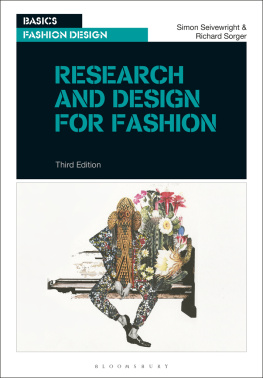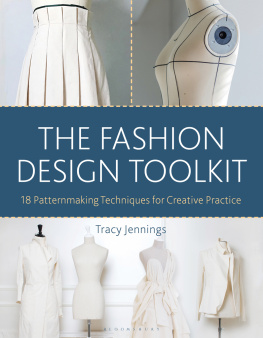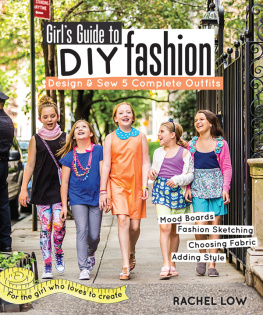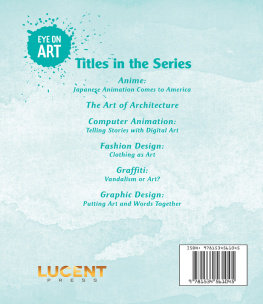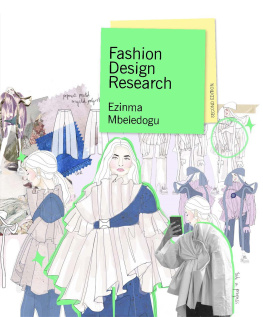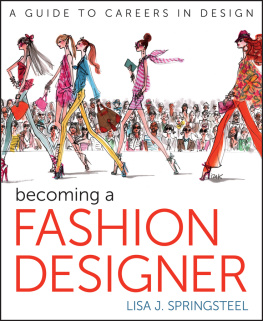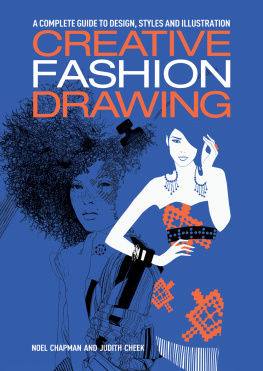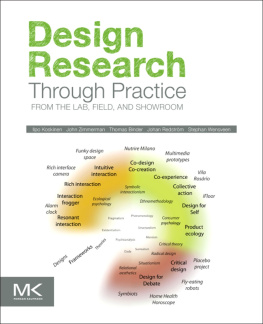
BLOOMSBURY VISUAL ARTS
Bloomsbury Publishing Plc
50 Bedford Square, London, WC1B 3DP, UK
1385 Broadway, New York, NY 10018, USA
This electronic edition published in 2020 by Bloomsbury Publishing Plc
BLOOMSBURY, BLOOMSBURY VISUAL ARTS and the Diana logo are trademarks of Bloomsbury Publishing Plc
First edition published in Great Britain by AVA Publishing SA, 2007
Second edition published by AVA Publishing SA, 2012
Third edition published by Fairchild Books, an imprint of Bloomsbury Publishing Plc
This edition published by Bloomsbury Visual Arts 2018
Reprinted 2019, 2020
Copyright Bloomsbury Publishing Plc, 2017
Simon Seivewright and Richard Sorger have asserted their right under the Copyright, Designs and Patents Act, 1988, to be identified as Author of this work.
Cover design: Louise Dugdale
Cover image Olivia Overton
All rights reserved
You may not copy, distribute, transmit, reproduce or otherwise make available this publication (or any part of it) in any form, or by any means (including without limitation electronic, digital, optical, mechanical, photocopying, printing, recording or otherwise), without the prior written permission of the publisher. Any person who does any unauthorised act in relation to this publication may be liable to criminal prosecution and civil claims for damages.
Bloomsbury Publishing Plc does not have any control over, or responsibility for, any third-party websites referred to or in this book. All internet addresses given in this book were correct at the time of going to press. The author and publisher regret any inconvenience caused if addresses have changed or sites have ceased to exist, but can accept no responsibility for any such changes.
A catalogue record for this book is available from the British Library.
The Library of Congress has cataloged the A&C Black edition as follows:
Names: Seivewright, Simon, author. | Sorger, Richard.
Title: Research and Design for Fashion / Simon Seivewright and Richard Sorger.
Description: Third edition. | New York : Fairchild Books, 2017. | Series: Basics fashion design | Includes .
Identifiers: LCCN 2016001549| ISBN 9781474246361 (paperback) | ISBN 9781474246378 (epdf)
Subjects: LCSH: Fashion design. | Fashion designStudy and teaching. | BISAC: DESIGN / Fashion.
Classification: LCC TT507 .S425 2016 | DDC 746.9/2076dc23 LC record available at http://lccn.loc.gov/2016001549
ISBN: 978-1-3501-0773-1 (PB)
ISBN: 978-1-4742-4638-5 (eBook)
ISBN: 978-1-4742-4637-8 (ePDF)
Series: Basics Fashion Design
To find out more about our authors and their books please visit www.bloomsbury.com where you will find extracts, author interviews and details of forthcoming events, and to be the first to hear about latest releases and special offers, sign up for our newsletters.

Contents

Maison Martin Margiela haute couture Spring/Summer 2015
Introduction
Research is vital to any design process, as it will provide you with the foundations with which to build and develop your desired creative outcomes. Research involves the initial hunt and collection of ideas prior to design. It should be an experimental process; an investigation to find out or support your knowledge of a particular subject, market, consumer, innovation, or technology.
Research is an essential tool in the creative process and is one that will provide you with information and creative direction, as well as a narrative to a collection. Research is about a journey of discovery that can often take weeks or even months to collate and process. It is also a very personal activity, which provides the viewer with an insight into the thinking, aspirations, interests, and creative vision of the designer.
By conducting in-depth and broad-ranging research, a designer can begin to interpret a series of garments or to evolve a collection. Silhouettes, textures and fabrics, colors, details, prints and embellishments, and market and consumer all have their place in the process of design and are found or directed by the research gathered.
This new edition of Research and Design for Fashion leads you through the essential stages of research and the translation of these stages into fashion design ideas. It discusses crucial elements in the research and design process, such as the brief and the constraints that it can sometimes impose. It explains the importance of identifying both your target market and customer, and of understanding the different levels and genres of fashion before setting out on the creative research itself. It then discusses the many possible avenues for research and the need to set a theme, concept, or narrative to your collection.
You then explore how to translate your research into early design ideas, looking at both 2D and 3D approaches. The book provides useful exercises for you to do that explain how to bridge the gap between the research and design outcomes. Design and collection development is broken down into a series of elements that then provide a foundation for expanding your ideas into a well-considered, cohesive, and balanced collection. Finally, the book shows and explores a variety of approaches to communicating and rendering your design work.
Interviews at the end of each chapter, featuring established international fashion designers, a trend forecasting agency, and fashion educators will inspire you on your creative journey throughout the book, and provide you with valuable insights into what it means to get into, work in, and succeed in the fashion industry.
Research and Design for Fashion will provide you with the basic fundamental skills and knowledge that you need to start you on your journey of designing an in-depth, innovative, and creative collection all of your own. Good luckand above all, enjoy the discovery of the creative design process!
Sadly, the original author of this book, Simon Seivewright, died in 2013.
I get my ideas out of my dreams... if youre lucky enough to use something you see in a dream, it is purely original. Its not in the worldits in your head. I think that is amazing.
Alexander McQueen, British fashion designer, 19692010

Japanese scene created by the master Kunisada, circa 1853.
Researchwhat and why?

